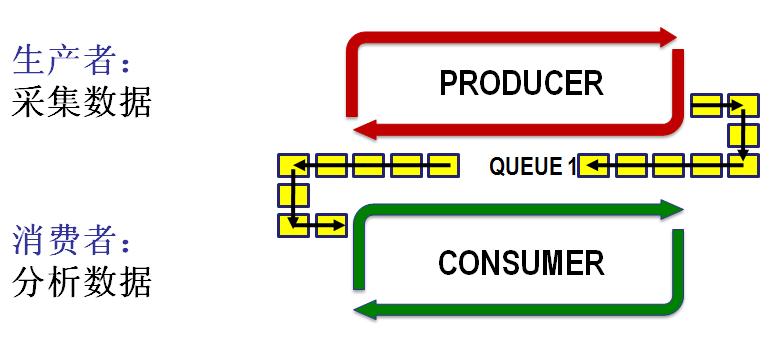生产者消费者问题(英语:Producer-consumer problem),也称有限缓冲问题(英语:Bounded-buffer problem),是一个多线程同步问题的经典案例。该问题描述了共享固定大小缓冲区的两个线程——即所谓的“生产者”和“消费者”——在实际运行时会发生的问题。生产者的主要作用是生成一定量的数据放到缓冲区中,然后重复此过程。与此同时,消费者也在缓冲区消耗这些数据。该问题的关键就是要保证生产者不会在缓冲区满时加入数据,消费者也不会在缓冲区中空时消耗数据。

但是在 leveldb 中有这么一段代码,很好的写出了一个后台线程传入事件异步并发执行执行。1
2
3
4
5
6
7
8
9
10
11
12
13
14
15
16
17
18
19
20
21
22
23
24
25
26
27
28
29
30
31
32
33
34
35
36
37
38
39
40
41
42
43
44
45
46
47
48
49
50
51
52
53
54
55
56
57
58
59
60
61
62
63
64
65
66
67
68
69
70
71
72
73
74
75
76
77
78
79
80
81
82
83
84
85
86
87
88
89
90
91
92
93
94
95
96
97
98
99
100
101
102
103
104
105
106
107
108
109
110
111
112
113
114
115
class PosixEnv
{
public:
PosixEnv() : started_bgthread_(false)
{
PthreadCall("mutex_init", pthread_mutex_init(&mu_, NULL));
PthreadCall("cvar_init", pthread_cond_init(&bgsignal_, NULL));
}
void Schedule(void(*function)(void*), void* arg)
{
PthreadCall("lock", pthread_mutex_lock(&mu_));
// Start background thread if necessary
if (!started_bgthread_)
{
started_bgthread_ = true;
PthreadCall(
"create thread",
pthread_create(&bgthread_, NULL, &PosixEnv::BGThreadWrapper, this));
}
if (queue_.empty())
{
// 如果当前队列为空,那么后台线程此时可能为信号等待状态,激活一个等待该条件的线程
PthreadCall("signal", pthread_cond_signal(&bgsignal_));
}
BGItem item = BGItem();
item.arg = arg;
item.function = function;
queue_.push_back(item);
// 当 unlock 后,pthread_cond_wait 获取到条件信号和锁,就会执行之后的代码
PthreadCall("unlock", pthread_mutex_unlock(&mu_));
}
static void* BGThreadWrapper(void* arg)
{
reinterpret_cast<PosixEnv*>(arg)->BGThread();
return NULL;
}
void* BGThread()
{
while (true)
{
// Wait until there is an item that is ready to run
PthreadCall("lock", pthread_mutex_lock(&mu_));// 这个mutex主要是用来保证 pthread_cond_wait的并发性
while (queue_.empty())
{
// 等待条件信号,并将锁交出去,当获取到信号量
PthreadCall("wait", pthread_cond_wait(&bgsignal_, &mu_));
// pthread_cond_wait 会先解除之前的 pthread_mutex_lock 锁定的 mtx,然后阻塞在等待对列里休眠,
// 直到再次被唤醒(大多数情况下是等待的条件成立而被唤醒,唤醒后,该进程会先锁定先 pthread_mutex_lock(&mtx);
}
void (*function)(void*) = queue_.front().function;
void* arg = queue_.front().arg;
queue_.pop_front();
PthreadCall("unlock", pthread_mutex_unlock(&mu_));
// 异步并行执行方法,如果将这句代码放在 unlock 之前那么就是异步串行了
(*function)(arg);
}
}
private:
void PthreadCall(const char* label, int result)
{
std::cout << label << std::endl;
if (result != 0) {
fprintf(stderr, "pthread %s: %s\n", label, strerror(result));
abort();
}
}
pthread_mutex_t mu_;
pthread_cond_t bgsignal_;
pthread_t bgthread_;
bool started_bgthread_;
struct BGItem { void* arg; void (*function)(void*); };
typedef std::deque<BGItem> BGQueue;
BGQueue queue_;
};
void speak(void* pstr)
{
std::string* str = reinterpret_cast<std::string*>(pstr);
printf("我要说话啦:%s\n", str->c_str());
}
int main(int argc, const char * argv[]) {
std::string str("哇哈哈哈啊哈哈哈啊哈哈");
std::string str2("你的豆腐的的地方水电费违反诶我去翁");
PosixEnv env = PosixEnv();
env.Schedule(&speak, &str);
sleep(10);
env.Schedule(&speak, &str2);
sleep(5);
return 0;
}
上面例子,把所有的事件模型包装成一个struct BGItem 的结构体,而通过 BGQueue 对消息队列进行处理,这里没有用到延时执行的消息队列,也没有优先队列的处理,只是一个简单的生产者——消费者的模型。
通过创建一个工作线程 bgthread_ 来开启线程运作,通过信号量 pthread_cond_wait 和 pthread_cond_signal 来进行控制工作线程的阻塞和运作。
该例子中,主线程负责生成事件模型,而工作线程负责消费处理事件模型,而消息队列,就是我们所说的缓冲区了。